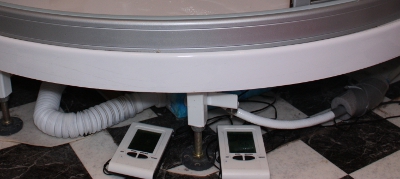
Testing of prototype #3 is now in its 45th week. We have been tracking cold water temperatures at the in- and output of the unit, as well as temperature difference of the drain water. From these temperatures, the performance of the heat exchanger can be calculated.
We have noticed a decrease of performance over time. This did not come as a big surprise, because we always knew that DWHR units are susceptible to fouling: the deposit of material within the unit (soap, skin flakes, hair, shampoo etc.) reducing heat exchanger effectiveness.
Our design uses copper tubing and a relatively high flow speed of the drain water to reduce fouling. Biological fouling can largely be eliminated by using copper pipes. Never the less, we found that some form of maintenance would be necessary to minimize the reduction in performance. We do not want the user to have to open the unit, nor would we like to use toxic, aggressive substances (e.g. caustic soda) to clean, so we tested with some alternative methods.
It was found that pouring 1-2 liters (½ gallon) of very hot water (e.g. waste water from boiling potatoes or pasta) through the unit restored to a great extend the performance. The reason for this became somewhat clearer when we opened the unit for inspection: the fouling on both the copper tubing and within the channels is a very loose substance that can easily be removed. So pouring in very hot water with a relatively high flow and force loosens and carries away a great amount of the fouling.
